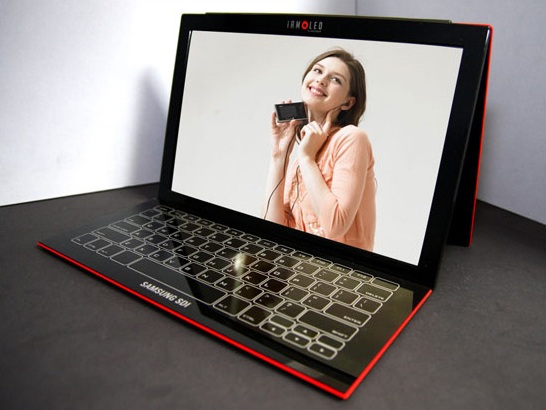Samsung OLED laptop prototype: latest developments
Coming soon: the most attractive laptop screen ever

Samsung SDI has unveiled a concept laptop using an active matrix OLED (AMOLED) with an advanced backplane driver, allowing for better driving of the high-resolution display.
Samsung’s prototype - developed for this year’s upcoming SID 2008 event in the US - has all the fancy gubbins: a touchscreen keyboard so light the screen needs a stand for balance, a technologically advanced monitor capable of super-high resolution and contrast.
But the technology behind the screen is what could make this announcement one of the most pivotal in the ‘OLEDs in laptops roadmap’.
Most OLEDs in use for mobile phones today use a technique called passive matrix driving, which uses a larger amount of power and has a lower refresh rate for movement - fine for smaller screens but tricky for laptops and TVs.
AMOLEDs have individual transistors throughout the display - allowing for more effective power consumption and more impressive graphics, but they cost more and are harder to fabricate without high failure rates.
Samsung’s WXGA (1280x768) also uses a more advanced manufacturing technique to create the TFT backplane for the screen - it may not seem important, but one of the biggest hurdles to OLED development is cost, so to develop a cheaper way of making them is a good thing.
All a silly con?
Sign up for breaking news, reviews, opinion, top tech deals, and more.
And after that, it gets a bit more technical, but again, very important in the future road map.
Silicon is used in the TFT backplane used to tell the pixels what to do, but can either:
Poly-silicon (poly-si) mostly used, effective but not really good enough at bigger sizes, especially in making the screens last long enough)
Amorphous silicon (a-si) good enough to provide 20 times the picture quality of poly-si, but unstable and expensive to use.
But Samsung has gone with a-si for the prototype, which might not seem exciting as they’ve done it before with other screens, but rumours are the technology is getting better all the time, especially as intensive development has begun in the OLED TV wars between the bigger companies.
It might be dull now, but could be the springboard for prettier, thinner displays in the future.

Gareth has been part of the consumer technology world in a career spanning three decades. He started life as a staff writer on the fledgling TechRadar, and has grew with the site (primarily as phones, tablets and wearables editor) until becoming Global Editor in Chief in 2018. Gareth has written over 4,000 articles for TechRadar, has contributed expert insight to a number of other publications, chaired panels on zeitgeist technologies, presented at the Gadget Show Live as well as representing the brand on TV and radio for multiple channels including Sky, BBC, ITV and Al-Jazeera. Passionate about fitness, he can bore anyone rigid about stress management, sleep tracking, heart rate variance as well as bemoaning something about the latest iPhone, Galaxy or OLED TV.